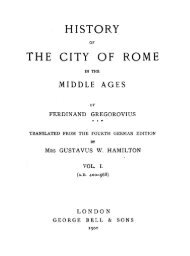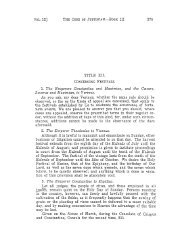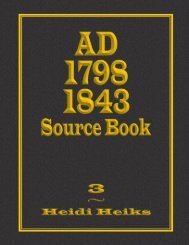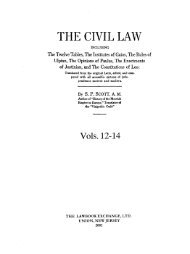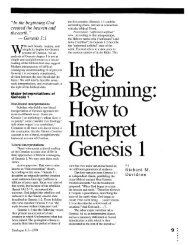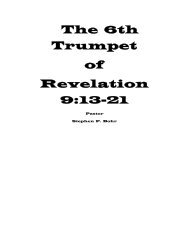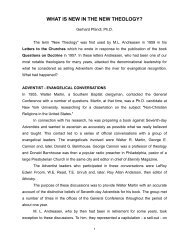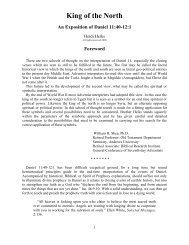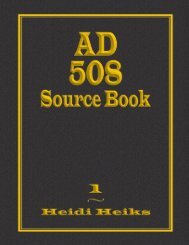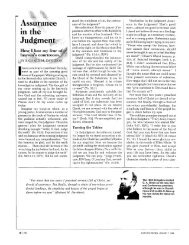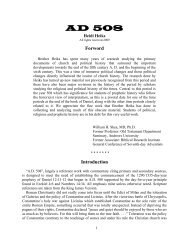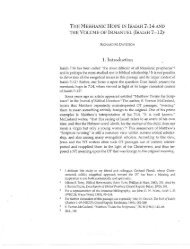You also want an ePaper? Increase the reach of your titles
YUMPU automatically turns print PDFs into web optimized ePapers that Google loves.
<strong>Judgment</strong> <strong>in</strong> <strong>Daniel</strong> 7k<strong>in</strong>gdom. While this localizes the k<strong>in</strong>gdom to theearth, it is also all-encompass<strong>in</strong>g<strong>in</strong> that it is the whole earth that is granted to them. Thus <strong>in</strong> additionto the primary statement that the k<strong>in</strong>gdom will be given to the sa<strong>in</strong>ts,the extent ofthat k<strong>in</strong>gdom is also emphasized. Ifthe first two cola were tostand alone, they would be called a synonymous bicolon. However, thethird colon, which adds the further thought about who will receive thek<strong>in</strong>gdom, makes this tricolon synthetic, follow<strong>in</strong>g the A:A:B pattern withits thematic elements.The f<strong>in</strong>al bicolon ofthis stanza (vs. 27) is particularly important for differentiat<strong>in</strong>gbetween the Son of man <strong>in</strong> the preced<strong>in</strong>g stanza (vss. 13-14)and the sa<strong>in</strong>ts ofthe Most High <strong>in</strong> this one. The poetic relations betweenthe f<strong>in</strong>al bicola ofthese two stanzas underscore that differentiation. At theoutset it may be noted that the f<strong>in</strong>al bicolon <strong>in</strong> the third stanza does notstart with a conjunction. Consider<strong>in</strong>g the fact that all of the preced<strong>in</strong>gbicola and the tricolon that follow from verse 24 on are connected withconjunctions. This disjunction is stylistically dist<strong>in</strong>ctive and emphasizes itsthematic differentiation.The way one translates the pronom<strong>in</strong>al suffIXes <strong>in</strong> the f<strong>in</strong>al bicolon obviouslyhas much to do with how one <strong>in</strong>terprets the relations ofthis poeticunit. As they stand <strong>in</strong> the Masoretic text, the suffIXed pronouns are <strong>in</strong> thethird person mascul<strong>in</strong>e s<strong>in</strong>gular form. It is his k<strong>in</strong>gdom that is everlast<strong>in</strong>g,and it is to him that all dom<strong>in</strong>ions shall give worship and obedience. Theconnection with the Son ofman <strong>in</strong> the preced<strong>in</strong>g stanza is clearly evident,if these translations of the pronouns are reta<strong>in</strong>ed.The pronouns can only be disposed of, as has been done by somemodern English versions, by emend<strong>in</strong>g the text; that is, by chang<strong>in</strong>g thepronouns from the s<strong>in</strong>gular ("his," "to him") to plural forms ("their," "tothem"). Manuscript evidence for the support of such an emendation islack<strong>in</strong>g.In addition, the prepositionallllme4 ("to, for") occurs ten times previously<strong>in</strong> the chapter with the s<strong>in</strong>gular pronom<strong>in</strong>al suffIX; it occurs onlytwice with the plural suffIX. In neither ofthe latter is the plural suffIX used<strong>in</strong> such a way as to identify the sa<strong>in</strong>ts with the Son of man. One would expect<strong>Daniel</strong> to have used the same plural suffIX, if he <strong>in</strong>tended to refer tothe sa<strong>in</strong>ts ofthe Most High. Thus it is evident that the translations adoptedby some ("their k<strong>in</strong>gdom" and "all dom<strong>in</strong>ions shall serve and obey them"[literally, "to them"]) do not follow the Aramaic text. In the two plural exampleswe have <strong>in</strong> the chapter, lehon <strong>in</strong> verse 12 refers to the beasts, and<strong>in</strong> verse 21 to the sa<strong>in</strong>ts, <strong>in</strong> this manner: the little horn prevailed "over132



